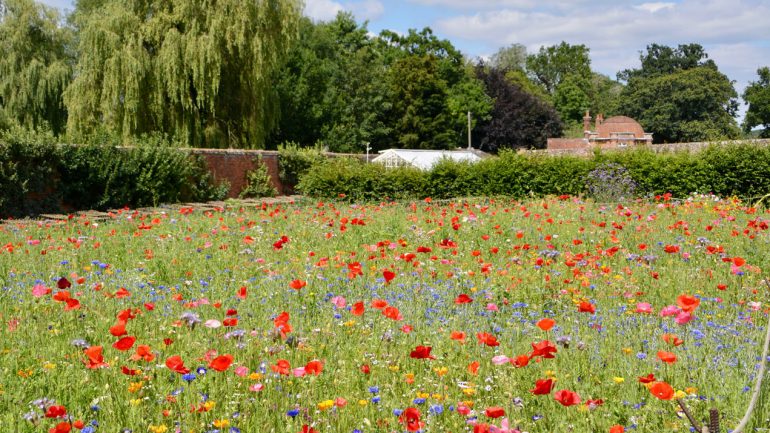Gardening for nature can be a beautiful sight. Throughout the summer a beautiful mini-meadow transforms the historic walled garden of National Trust property The Vyne near Basingstoke.
Over 50 varieties of wildflower create a swathe of nodding red, blue, orange and white flowerheads, flooding the space with colour and movement. The plants, ranging from poppies and rose campion to larkspur and corn marigold, are specially chosen by The Vyne’s garden team for their vibrancy. Not only do they wow the visitors, but they also help to entice insects like bees and hoverflies, butterflies and moths, providing them with an essential source of pollen and nectar.
If you visit The Vyne this summer, you’re in for a real treat. You’ll be able to find out why pollinators are so important for our gardens, and get simple top tips on how you can help wildlife in your own outdoor space.
PICTURED ABOVE: Flower meadow, National Trust Images, Lesley Barnwell
The Vyne summer border | National Trust Images, John Miller
Borage in the flower meadow | National Trust Images, Lesley Walsh
Although there’s a soft rope boundary around the meadow itself, to protect the fragile flowers and grasses from being trampled, it’s still very easy to get up close to the mass of flowerheads – the perfect spot for a special family photo, or just to relax and soak up the scene and the gentle buzz of bees going about their business.
Senior gardener Chris Wilson: “I’ve always been in awe of the amazing variety of insects that are attracted to our wildflowers, and the good that they do to other areas of the garden and to our ecosystem. Pollinating, fighting off aphid infestation on vegetables, feeding the next layer of the food chain… it’s all in a day’s work.
“This little meadow really is a joy to explore. Within a single day the display can treat you to so many wonderful changes, as new flowers burst open, and colours fade or become more vibrant as the light and clouds change overhead.“
This is the second year The Vyne has planted its pop-up meadow, and not surprisingly, kids have loved it. An important aim of the project is to inspire children to want to know more about the incredibly valuable relationship between plants and insects. This year, there’s a special quiz trail, to help them identify bugs they may see in the walled garden and around the grounds.
And it’s not just about the meadow flowers; there’ll be beautiful displays of sunflowers too, and sweet-smelling sweetpeas which will also be for sale in bunches from the little garden kiosk.
Flower meadow | National Trust Images Lesley Walsh
Interested in creating your own flower meadow patch?
You don’t need loads of room!
Creating a flower meadow area is a wonderful way to attract more pollinators to your garden. Without bees, butterflies, wasps, flies and beetles we’d have no flowers, fruit and veg. The flowering grasses in a meadow provide shelter for wildlife and protect the soil from excess evaporation, and the insects in turn are food for countless birds and mammals.
Where’s the best spot?
A sunny, sheltered location is ideal. Many meadow plants originated in open areas and need the sunshine to flourish. Shelter will protect the delicate flowers from flopping over. An area as small as 2m x 2m will create both a pleasing display for you and food for pollinators.
Where do I start?
First you need to remove as much grass as you can – garden grass has been selectively bred to be a thug and will out-compete most meadow species. Remove as much of the topsoil as possible as meadow flowers aren’t suited to a rich environment and will cause weak, sappy growth.
Turn over the remaining soil down to 20cm, level it and sow a meadow seed mix. The wildflower mix that works for you will spend on the climate and geology of where you live. Different flowers will thrive in a chalky soil to a clay or acidic one. The great thing about a meadow is that it’s cheap and easy to test and learn. Be prepared to water the soil in dry spells – if the seeds dry out whilst they are germinating, they won’t recover.
The Vyne house and lake | National Trust Images, John Miller
Find out more about The Vyne at www.nationaltrust.org.uk/the-vyne
Words by the National Trust.






Leave a Reply